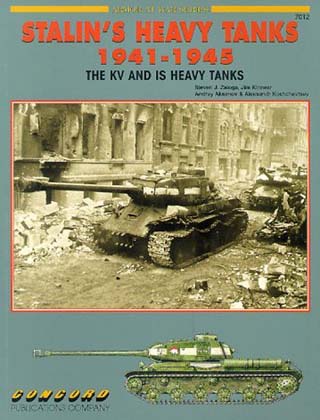Stalin’s Heavy Tanks 1941–1945
The KV and IS Heavy Tanks
Armor At War Series Book Review

The book covers Soviet T-35, KV serie, IS-2 and IS-3 heavy tanks in combat in World War 2, as well as their assault gun sub-variants. The core of this publication consists of many new photos discovered in archives in Russia and Central Europe. It is a companion book to an earlier publication covering the Soviet medium tanks.
72 Pages, Paperback
186 Photos, 16 Colour Illustrations
ISBN: 9623616163
CONCORD PUBLICATIONS COMPANY, 1997
Authors
- Steven J. Zaloga
- Jim Kinnear
- Andrey Aksenov
- Aleksandr Koshchavtsev
Evaluation
The 10-page introduction includes a concise history of the early Soviet heavy tank projects, of which only the KV tank went into series production, followed by the universal tank concept which was given up in favour of an uparmed T-34 and the new IS heavy tank.
The official designations of the main armament mounted in Soviet heavy tanks is mentioned in the introduction, except that the calibre lengths have been ommitted. In the case of the 76.2 mm F-32 and F-34 tank guns, the difference in calibre length would have been important to know. What is interesting to note is that the F-34 tank gun was designated ZIS-5 when mounted in KV-1 heavy tanks.
The organization and tactical deployment of heavy tank regiments is covered briefly.
Photos and colour illustrations are well layed out, and the captions are most interesting to read. Some caption text is repeated when photos show a previously covered vehicle operated by a particular unit and/or crew.
The photographs show a variety of vehicles with distinct tactical markings, and slogans. Translations of slogans are provided. Several units and vehicle commanders have been identified, making the book a good source of background information for wargamers and diorama builders.
Several photos show the cramped working conditions inside Soviet heavy tanks and their assault gun sub-variants. The book briefly mentions the command and control problems associated with the fact that the KV-1 vehicle commander also served as the loader of the main gun. This archaic turret layout was changed when the new KV-1S was introduced.
The colour illustrations include a captured KV-2 of Panzerkompanie (z.b.V.) 66 with German tropical camouflage, and a KV-1E in the Finnish three tone pattern of Moss Green, Earth Brown, and Army Grey which was adopted in 1944. The employment, and conversion of captured vehicles would make an interesting publication on its own.
The photos show captured T-35 heavy tanks with markings of the Slovak army and Ukrainian nationalist forces fighting alongside the Wehrmacht.
Photos and colour plates of the IS-3 and IS-3M extend the usefulness of this publication well into the post-war period. There are even photos of the IS-4 which might have intervened in the Korean War if Stalin had not been deterred by the possibility of a general war with the nuclear-armed USA.
The colour illustrations would have been even more useful to the modeller if suitable model colour reference numbers had been provided in the captions.
The assault gun sub-variants of the KV and IS heavy tank are covered, but they really deserve a book of their own to capture the important aspects of their design, deployment, and combat experience.
The book is a good source of concise and easy to read information on the Soviet heavy tanks, it’s an excellent starting position for further study into this subject. The colour plates, and many of the wartime photos are an inspiration for modellers and diorama builders.
Sample from APC Hobbies